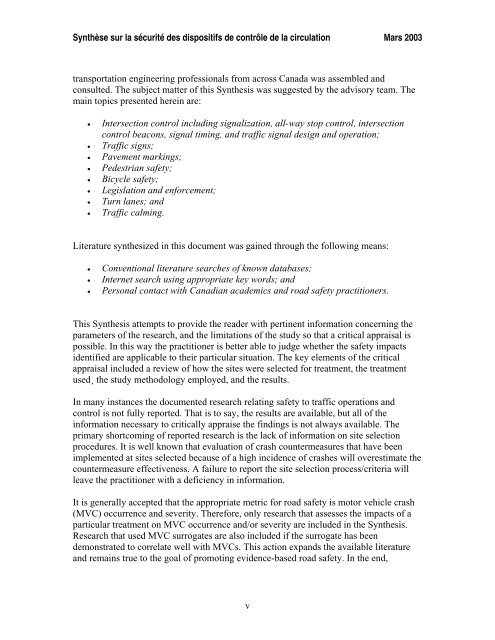Synthèse sur la sécurité des dispositifs de contrôle de la circulation
Synthèse sur la sécurité des dispositifs de contrôle de la circulation
Synthèse sur la sécurité des dispositifs de contrôle de la circulation
Create successful ePaper yourself
Turn your PDF publications into a flip-book with our unique Google optimized e-Paper software.
Synthèse <strong>sur</strong> <strong>la</strong> sécurité <strong><strong>de</strong>s</strong> <strong>dispositifs</strong> <strong>de</strong> contrôle <strong>de</strong> <strong>la</strong> circu<strong>la</strong>tion Mars 2003<br />
transportation engineering professionals from across Canada was assembled and<br />
consulted. The subject matter of this Synthesis was suggested by the advisory team. The<br />
main topics presented herein are:<br />
• Intersection control including signalization, all-way stop control, intersection<br />
control beacons, signal timing, and traffic signal <strong><strong>de</strong>s</strong>ign and operation;<br />
• Traffic signs;<br />
• Pavement markings;<br />
• Pe<strong><strong>de</strong>s</strong>trian safety;<br />
• Bicycle safety;<br />
• Legis<strong>la</strong>tion and enforcement;<br />
• Turn <strong>la</strong>nes; and<br />
• Traffic calming.<br />
Literature synthesized in this document was gained through the following means:<br />
• Conventional literature searches of known databases;<br />
• Internet search using appropriate key words; and<br />
• Personal contact with Canadian aca<strong>de</strong>mics and road safety practitioners.<br />
This Synthesis attempts to provi<strong>de</strong> the rea<strong>de</strong>r with pertinent information concerning the<br />
parameters of the research, and the limitations of the study so that a critical appraisal is<br />
possible. In this way the practitioner is better able to judge whether the safety impacts<br />
i<strong>de</strong>ntified are applicable to their particu<strong>la</strong>r situation. The key elements of the critical<br />
appraisal inclu<strong>de</strong>d a review of how the sites were selected for treatment, the treatment<br />
used¸ the study methodology employed, and the results.<br />
In many instances the documented research re<strong>la</strong>ting safety to traffic operations and<br />
control is not fully reported. That is to say, the results are avai<strong>la</strong>ble, but all of the<br />
information necessary to critically appraise the findings is not always avai<strong>la</strong>ble. The<br />
primary shortcoming of reported research is the <strong>la</strong>ck of information on site selection<br />
procedures. It is well known that evaluation of crash countermea<strong>sur</strong>es that have been<br />
implemented at sites selected because of a high inci<strong>de</strong>nce of crashes will overestimate the<br />
countermea<strong>sur</strong>e effectiveness. A failure to report the site selection process/criteria will<br />
leave the practitioner with a <strong>de</strong>ficiency in information.<br />
It is generally accepted that the appropriate metric for road safety is motor vehicle crash<br />
(MVC) occurrence and severity. Therefore, only research that assesses the impacts of a<br />
particu<strong>la</strong>r treatment on MVC occurrence and/or severity are inclu<strong>de</strong>d in the Synthesis.<br />
Research that used MVC <strong>sur</strong>rogates are also inclu<strong>de</strong>d if the <strong>sur</strong>rogate has been<br />
<strong>de</strong>monstrated to corre<strong>la</strong>te well with MVCs. This action expands the avai<strong>la</strong>ble literature<br />
and remains true to the goal of promoting evi<strong>de</strong>nce-based road safety. In the end,<br />
v
















